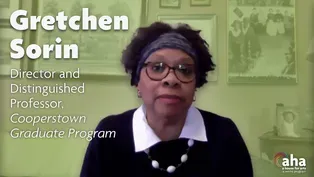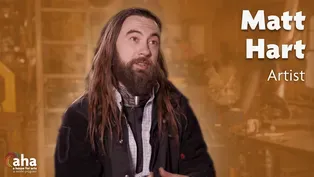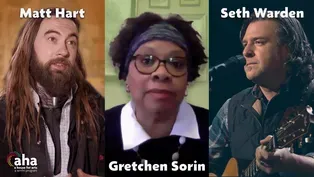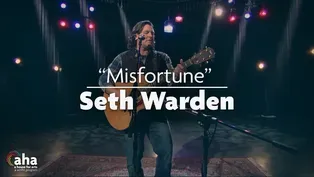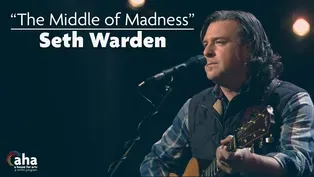
AHA! | 634
Season 6 Episode 34 | 26m 46sVideo has Closed Captions
Fly fishing metal work, the history of race and the automobile in the US, & a performance.
Artist Matt Hart has combined his love of fly fishing and metal work to create unique sculptures honoring the craftmanship of fly tying. Author Gretchen Sorin's latest book, Driving While Black, analyzes the history of race and the automobile in the US. Catch Seth Warden, from Warden and Co., singing "The Middle of Madness " and more
Problems with Closed Captions? Closed Captioning Feedback
Problems with Closed Captions? Closed Captioning Feedback
AHA! A House for Arts is a local public television program presented by WMHT
Support provided by M&T Bank, the Leo Cox Beach Philanthropic Foundation, and is also provided by contributors to the WMHT Venture Fund including Chet and Karen Opalka, Robert & Doris...

AHA! | 634
Season 6 Episode 34 | 26m 46sVideo has Closed Captions
Artist Matt Hart has combined his love of fly fishing and metal work to create unique sculptures honoring the craftmanship of fly tying. Author Gretchen Sorin's latest book, Driving While Black, analyzes the history of race and the automobile in the US. Catch Seth Warden, from Warden and Co., singing "The Middle of Madness " and more
Problems with Closed Captions? Closed Captioning Feedback
How to Watch AHA! A House for Arts
AHA! A House for Arts is available to stream on pbs.org and the free PBS App, available on iPhone, Apple TV, Android TV, Android smartphones, Amazon Fire TV, Amazon Fire Tablet, Roku, Samsung Smart TV, and Vizio.
Providing Support for PBS.org
Learn Moreabout PBS online sponsorship- Taking metals to the next level.
Gretchen Sorrin reveals the history of race and the automobile in America The catchy performance by Seth Warden.
It's all ahead on this episode of AHA, A House for Arts - Funding for AHA has been provided by your contribution and by contributions to the WMHT venture fund.
Contributors include Chet and Karen Opalka, Robert and Doris Fischer Malesardi, The Alexander and Marjorie Hover Foundation and The Robison Family Foundation.
- At M & T Bank we understand that the vitality of our community is crucial to our continued success.
That is why we take an active role in our community.
M & T bank is pleased to support WMHT programming that highlights the arts, and we invite you to do the same.
(Flute music begins) - Hi, I'm Laura Ayad and this is AHA.
A house for Arts, a place for all things creative.
Let's send it right over to Matt Rogowicz for today's field segment.
- I'm here in Schodack Landing, New York on a very windy spring day, to look at artist Matt Hart and his amazing metal sculptures.
Let's go.
- [Matt] I work with metal, I do sculpture, railing, signs, anything custom.
I like to do things that haven't been done before.
So I tend to make a lot of my projects harder than they need to be.
As I started Hartist Metals, that's my business, custom creation, sculpture design and function in 2007 and you know, focused on nature.
Meaning when I make railings I like the balustrades to be natural, not symmetrical.
Oh, we did a giant butterfly, that one commemorated the Karner butterfly, which was really nice.
I went to the library, then went up to the Pine Bush Preserve, that one's still there.
I liked that Growing up, my father was in the sheet metal fabrication union and I got in, started sweeping the floors and tinkering with little pieces.
And I remember my foreman and my coworkers used to say, Oh, Matt, you need to be in you know, Napa Valley making little funky sculptures.
So that naturally led to playing with scraps and welding things together.
The Albany underground artists was a good movement that guild, and that was very inspiring.
So that got me into a group of artists making different things than what we were making in the fab shops.
One of the first big sculptures dad and I made was the the space-based man, that rock and roll guitar player.
That's downtown Broadway in the windows now, but that opened our eyes opened the doors.
People would say it's a dying trade, you know, the metal world.
And I just, I saw a window and I like the idea of functionality So you could make an artistic sculptural table but it's functional, people can set stuff on it, so that, that functionality really got me excited.
The whole time I was working on all those pieces, I knew it wasn't it, I was still searching and looking The forge flight are these new fly fishing sculptures My experience at the shows, when people walk around, I hear a lot of, I've never seen this before.
Holy, how did you do this?
And that is just fueling my fire All these years I've been waiting and looking and praying for something that hasn't been made before.
And these forged flies were were just it.
So I make the sculptures of the flies that we use catch the trout.
The mayflies have a life cycle.
They start as a nymph underwater and then they emerge and they pop their wings and then they fly and they drop their eggs So there's a few stages of their life.
And we create them out of copper, stainless steel.
Trying to get the metals to imitate all these fluffy and intricate fibers of the fly time world.
This is one of my favorite techniques that I've ever done in my life.
This is the imitation of the hackle.
So when we tie the flies with the saddle hackle feather, and you wrap this around the hook shank, the feathers splay out.
So this here, this is, you know and I love it when people walk up to these cause they, wow, how did you do that?
But then also looks like we weld each one on individually, and this has come through a long process of figuring out how to do this.
But when I figured out how to do this, I was like a kid in the candy store.
So this year we literally trade half of one of these feathers and then wrap it around the hook shank.
So this splays out, so a lot of the techniques that we use for the forge fly is actually very similar to the world of fly time.
And I think that really, people in the sport really connect with that.
This has got to be in one of my top three favorite pieces I've ever made, just because of this part right here.
This was over 10 foot of a saddle hackle feather I wrapped and stacked and then trimmed.
And when you tie the actual is called spun deer hair.
So when you spin the deer hair, then you shave it with a razor blade on the flies, And it leaves these little nubs.
And this here I just, I can't believe this came out.
This is still one of those pieces and I made it three years ago, but every time I look at it I'm like how, when and who - [Matt] The forge fly, There's no end to the possibilities and combinations of colors and materials are probably endless.
I'm probably making forge fly sculptures until till the end of time.
Guiding and teaching fly fishing and making the sculptures, that goes hand in hand.
It's kind of a dream come true.
- Gretchen Sorrin is a distinguished professor and director at the Cooperstown Graduate program, a training program for museum professionals, her latest book "Driving While Black" analyzes the history of race and the automobile in the U.S. How did African-Americans use cars as vehicles for social justice in Jim Crow America.
I talk with Gretchen to find out.
Gretchen welcome to A House for Arts, It's a pleasure having you.
- [Gretchen] Thank you, Lara.
It's great to be here.
- So you are the director of the Cooperstown Graduate program and a distinguished professor who trains students in work at museums.
And I know you've also served as consultant to over 200 museums, and that you specialize in African-American history and art.
So tell me first, how do you, how do you use your specialty in African-American art history to help museums reach more visitors on meaningful ways?
- You know, I think as a historian, and I'm a historian not an art historian, I teach my students how to contextualize art and how to use it, to get people really excited about American history and culture.
So I would say that, I look at it as an art historian but I also look at it as cultural artifact and what can we learn about it?
What can we learn about ourselves?
You know, what can we learn about the artists that produced it?
And hopefully to get people really excited about it.
I also really like to juxtapose art from the past with contemporary pieces.
And I think that gives us a new way of looking and thinking about art.
- Yeah.
Is there any specific example of that that comes to mind for you right away?
That's been really effective for helping people understand this form of history?
- Well, I think you're familiar with Fred Wilson and his work and juxtaposing objects with art pieces.
And right now my students are working on an exhibition about African-American mobility.
And one of the things that we're looking at is the Amistad affair, which is the ship that was shipwrecked off the coast of Connecticut in the mid 19th century.
- They made a famous movie off of that in the 90s.
Right?
I think so.
- Yeah.
And the, the Amistad was a slave ship that was taken over by the enslaved people and they wanted to go back to Africa.
So we're using, we're talking about mobility in the 21st century and 20th century but we're also comparing it to mobility in the 19th century.
And we're using art as well as artifact to do that.
- Right.
You know, Gretchen it's sounds like you're using exhibitions and museum collections to help people understand the truth because we've been hearing a lot in the news lately about disinformation and fake news, and searching for the truth, you know in the news and at college campuses.
Can you maybe tell us a bit more about how do exhibitions have the power to help us find the truth?
- You know, one of the things about museums I think that I find so appealing is authenticity.
The objects are real, the objects are authentic and you're looking at this kind of real piece of the past that can help you understand it.
And, and that's, we talk to our students about research and how important it is to really dig into that research and not to just look at one single source but to look at multiple sources and to really question all of those sources and where the information is coming from.
So you never just look at one single thing.
You're looking at newspapers and magazines.
You're looking at artist's statements, as well as art.
You're looking at artifact and you're verifying everything that you do.
- I want to switch gears a little bit from your museum work to your writing, albeit having to still do with social justice.
Really.
I understand last year you published a book called "Driving While Black."
So if I have this right, this is a book that analyzes the history of race in the automobile, in the U.S. right?
- Yes.
- So how did African-Americans use cars as a vehicle both literally and metaphorically for social justice in Jim Crow America?
Tell us a bit about that.
- Well, I have to say that you couldn't have the civil rights movement without the automobile.
When you think about the number of white Americans and black Americans that went South during the civil rights movement to participate in marches and demonstrations, they needed places to stay and they needed places to eat.
And the variety of businesses that grew up to support African-American automobile travelers, whether they were segregated motels, restaurants, hotels little luncheon, luncheon spots, all of these places were available to civil rights workers when they went South.
The other thing I think that's really important, is if you think about the bus boycotts.
In order to desegregate the buses in various towns in the South, they had to boycott the buses in order to boycott them, they didn't want people to lose their jobs to lose their source of income.
so they purchased fleets of automobiles that were used to drive people to work.
Those automobiles really made it possible for the bus companies to be bankrupted.
And that's what desegregated the buses.
- That's incredible.
Yeah.
And I understand too, that you worked with Rick Burns who's Ken Burns' brother on making a film based off your book right?
Tell us about that.
What's the title of the film and what was it like working on this?
- The film has the same first title as the book "Driving While Black", but the subtitle of the film is race, space, and mobility in America.
And Rick is an old friend.
I took him, we went to lunch together after we were on a panel for OAH, the organization of American historians.
And I told him that I had a story idea that I wanted to pitch to him.
And I wanted him to look at some pictures and I pulled out my laptop in a restaurant in Manhattan.
And we just started flipping through all of the pictures that I had collected of African-Americans and their automobiles.
And it was interesting because the hostesses and the waiters and waitresses in the restaurant gathered behind us and they were looking at the photographs as well.
- Wow.
So they were all just kind of like watching this whole history unfold in a way.
- And that's how we got started.
And, you know, I think Rick was a little nervous about doing an African-American history topic thinking, well maybe it should be a black filmmaker.
And my feeling was he was someone that I knew and it was really important to me to work with someone that I knew to do this story in particular because it was so important to me but also that African-Americans need white allies.
We need allies and supporters.
African-American community is only about 13% of the U.S. population, so we can't do all of this work ourselves, we need white allies.
- Right.
Absolutely.
And bringing forward those important stories through both a book, as well as a film format.
That's so important.
And you know, it's making me think about our current situation actually.
And Gretchen I'm curious to know do you think there's anything we can learn both from the book and the film that can help us understand our current situation, for instance do you see any parallels between what African-American drivers had to deal with and how they use the automobile 60 years ago and, how black American drivers deal today?
- Yeah.
I think what the film does and what the book does in more detail is really provide a context for understanding what's happening today.
It really shows us where we've been.
And one of the things that the book really talks about is the origin of police departments.
Because police departments in this country, really begin as slave catchers.
And as people who were working to restrict the movement of both African-Americans and Native Americans, depending on what part of the country the police department was established in, And when you understand that and you really start to see how that tension between African-Americans and the police has developed over time.
Of course, during the period of segregation many of the police were not supportive of the civil rights movement, and they were, you know sicking dogs on people and, and hurting, murdering people as well.
And letting people out of jail so that they could be captured recaptured by the clan, you know so you can start to see where that animosity and that that real fear comes from that we see today in traffic stops.
- Yeah.
Do you think that even police departments today kind of engage in some similar practices as well that restricts the movement and the mobility of many African American men and women?
- I think that not only, it's not only the police, I mean I think Americans have absorbed this, these ideas about white space and black space, and that there are spaces that African-Americans are not supposed to be in because you find people, you know calling the police because they find a young woman sleeping in a dorm, say at, Harvard or Yale.
And of course she's a student but they've called the police.
Or they call the police because there are people, black people sitting in a Starbucks and they don't think they should be sitting there.
Or they call the police, or they murder someone like Ahmed Aubrey running in a white neighborhood because it's perceived to be a space that he shouldn't be in.
So I think this is not just the police, but I think ordinary citizens are guilty of this as well.
- That's sounds like many Americans no matter what profession they're in, no matter what their background, could really benefit from, reading your book and watching the film and learning a bit about this history so that we can all know how to get together and help support each other and really help support the freedom and the mobility of black Americans today.
- Yes, I hope so.
And I think it's really an important part of history that we don't teach in schools.
- Yeah, absolutely.
Gretchen, thank you so much for being on the show, it was such a pleasure having you.
- [Gretchen] Thank you so much.
It was great to be here - Please.
Welcome Seth Warden.
- Hi there.
My name is Seth Warden.
I play in a group called Warden and Company.
This for someone who plays, it's called The Middle of Madness.
And I think we've all felt like we've been in the middle of that recently.
So this is my interpretation.
♪ Guitar music begins ♪ ♪ Life's getting blurry from the tears in my eyes ♪ ♪ a chance for change, adjust, just to sympathize.
♪ ♪ How can we fix this is there hope for us all ♪ ♪ when you're dying to climb just to watch it fall.
♪ ♪ Oh, we're in the middle of the madness ♪ ♪ whose mouth speaks for you ♪ ♪ inside all of this sadness ♪ ♪ is yours, mine, and the truth.
♪ ♪ I canceled my cable, I turned off the news ♪ ♪ I'm wise and I'm able and it's time to choose.
♪ ♪ It's taught to our children, this golden rule.
♪ ♪ And when it's time to use it ♪ ♪ grownups rarely do ♪ ♪ Oh were in the middle of the madness ♪ ♪ whose mouth speaks for you ♪ ♪ inside all of this sadness ♪ ♪ is yours mine and the truth ♪ ♪ we're in the middle of the madness ♪ ♪ whose mouth speaks for you ♪ ♪ inside all of this sadness ♪ ♪ is yours, mine and the truth.
♪ ♪ Guitar instrumental ♪ ♪ Oh we're in the middle of madness ♪ ♪ Who's mouth speaks for you ♪ ♪ Inside all of this sadness ♪ ♪ Is yours, mine, and the truth ♪ ♪ Guitar instrumental ♪ - This song is called Misfortune.
♪ Upbeat guitar begins ♪ ♪ Upbeat guitar begins ♪ ♪ Upbeat guitar begins ♪ ♪ What are you waiting for?
♪ ♪ You never really know for sure ♪ ♪ until you make a move.
♪ ♪ Is this what you expected?
♪ ♪ It's all cause and effected.
♪ ♪ So what are you gonna do?
♪ ♪ So here's to you misfortune ♪ ♪ Standing outside your door ♪ ♪ Is it really true, take precaution ♪ ♪ Could it be the one you've been waiting for ♪ ♪ Is this what you wanted ♪ ♪ Living in a house that's haunted ♪ ♪ with forgotten memories ♪ ♪ When all you did was exist in ♪ ♪ in opportunity, this is ♪ ♪ the one that could set you free.
♪ ♪ So here's to you misfortune ♪ ♪ standing outside your door.
♪ ♪ Is it really true, take precaution?
♪ ♪ Could it be the one you've been waiting for ♪ ♪ Is it time to make things happen, ah ♪ ♪ It is time to take some action, ah ♪ ♪ Is that all it takes ♪ ♪ So what are you waiting for ♪ ♪ What are you waiting for ♪ ♪ What are you waiting for ♪ ♪ What are you waiting for ♪ ♪ So here's to you misfortune ♪ ♪ Standing outside my door ♪ ♪ Is it really true, take precaution ♪ ♪ Could it be the one you've been waiting for ♪ ♪ Upbeat Guitar instrumental ♪ - Thanks for joining us For more arts visit wmht.org/aha and be sure to connect with WMHT On social I'm Lara Ayad, thanks for watching - Funding for aha has been provided by your contribution and by contributions to the WMHT venture fund.
Contributors include Chet and Karen Opalka, Robert and Doris Fischer Malisardi, The Alexander and Marjorie Hover Foundation and The Robison Family Foundation At M & T Bank We understand that the vitality of our community is crucial to our continued success.
That is why we take an active role in our community.
M & T Bank is pleased to support WMHT programming that highlights the arts, and we invite you to do the same.
AHA! 634 | Gretchen Sorin on Driving While Black
Video has Closed Captions
Clip: S6 Ep34 | 11m | Learn how African Americans used cars as vehicles for social justice in Jim Crow America. (11m)
AHA! 634 | Metal Working with Artist Matt Hart
Video has Closed Captions
Clip: S6 Ep34 | 5m 45s | See how Matt Hart is taking metals to the next level. (5m 45s)
Video has Closed Captions
Clip: S6 Ep34 | 30s | Fly fishing metalwork, the history of race and the automobile in the US, & a performance. (30s)
AHA! 634 | Seth Warden - "Misfortune"
Video has Closed Captions
Clip: S6 Ep34 | 3m 38s | Catch Seth Warden, from Warden and Co., sing "Misfortune" at WMHT Studios. (3m 38s)
AHA! 634 | Seth Warden - "The Middle Of Madness"
Video has Closed Captions
Clip: S6 Ep34 | 3m 17s | Catch Seth Warden, from Warden and Co., sing "The Middle of Madness" at WMHT Studios. (3m 17s)
Providing Support for PBS.org
Learn Moreabout PBS online sponsorshipSupport for PBS provided by:
AHA! A House for Arts is a local public television program presented by WMHT
Support provided by M&T Bank, the Leo Cox Beach Philanthropic Foundation, and is also provided by contributors to the WMHT Venture Fund including Chet and Karen Opalka, Robert & Doris...
